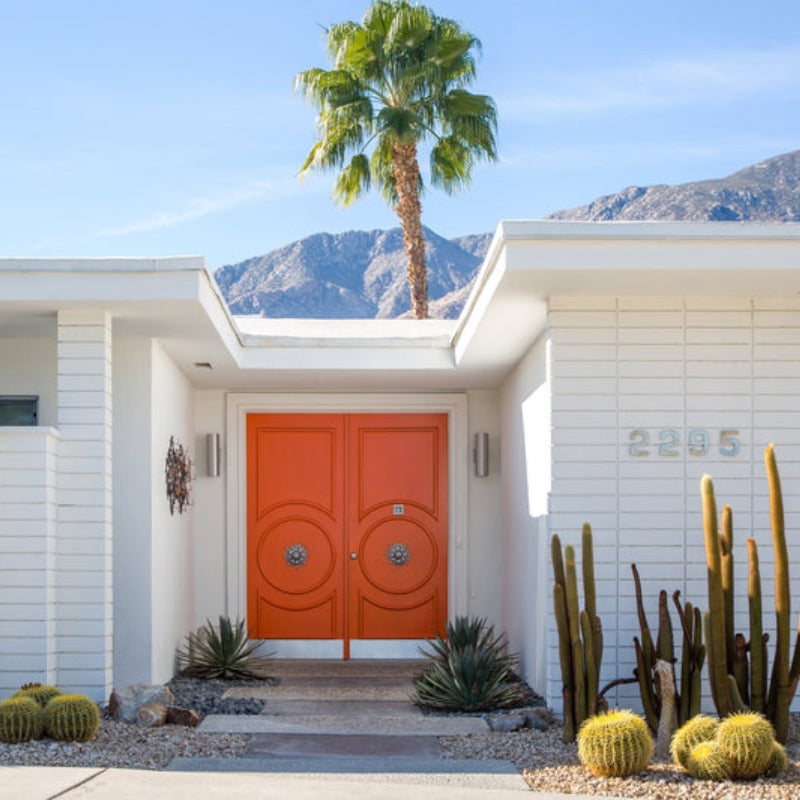
By Gina Teichert
Photo credit: La Semaine du Modernisme
Modernism Week is taking place online, offering access to all, as never before.
At Yellowpop, we're passionate about design. For us, and 150,000 industry professionals, that usually means traveling to Palm Springs for Modernism Week. It's part lecture series, part architectural tour, and part pure mid-century madness. And if you love neon lights and vintage signs as much as we do, a nighttime stroll through the Coachella Valley is always inspiring.Of course, this year will be different! So we sat down with Modernism Week's PR director, Bob Bogard, to talk about preserving old-world architecture, the future in the wake of pandemic, and what happened to our flying cars.
Mid-Century Architecture: Preserving the Golden Age of Palm Springs
Personally, there are so many things I love about Palm Springs," says Bob Bogard. "First and foremost, it's the only community I've lived in where the architecture of the city determines your whole life. People are very knowledgeable about architectural styles and the architects themselves," he continues. "You know, I've never lived in a city where you had to, sort of, learn who the architect of every great building was. Yet it's really important. "Indeed, Palm Springs and the Coachella Valley boast a pretty impressive resume.
Photo by Donald Wexler
They read like a Who's Who of mid-century architecture, with names like Donald Wexler, Albert Frey, Hugh Kaptur and E Stewart Williams. In the 1950s and 1960s, big names weren't just on architectural projects. Elvis, Marilyn, Sinatra and many others escaped to this desert oasis, located 100 miles east of Los Angeles.
"Palm Springs is unique in that there was a lot of mid-20th century architecture in the 1950s and 1960s," Bogard says. "Then in the '70s, '80s and early '90s, the Palm Springs economy kind of collapsed and stagnated," he notes.
Palm Springs Art Museum
David A Lee
"Normally, in another city, the architecture built in the 1950s and 1960s would have undergone some sort of remodeling in the 1970s and 1980s. But because the economy wasn't doing so well in Palm Springs, we accidentally preserved huge portions - I'm talking about entire neighborhoods - of homes built in the 1960s," Bogard says. "And then, in the 1990s, people realized what gems they were sitting on, and lovingly restored those buildings."
There were, however, a few mid-century gems lost in the creation of the suburb in the Tuscan desert. The Richard Neutra-designed Maslon House was demolished to make way for the new style sweeping cities like Phoenix and Las Vegas. Its loss was a turning point for the Palm Springs design community. So they decided to invest in preserving this heritage and become its advocates.
The Coachella Valley is still full of architectural icons: from the iconic Abernathy and Edris residences on Instagram to the stark desert landscapes punctuated by boulders, palms and Joshua trees, the iconic is everywhere. And, thanks to forward-thinking, vintage-loving owners and community leaders, they'll be there for the next generation to enjoy.
Virtual property tours and online conferences: the future of design events
The 15th edition of Modernism Week is evolving to adapt to social distancing. What's new? Virtual programming. In a typical year, the nonprofit behind Modernism Week - and other community organizations - hosts up to 400 events. This year, they'll host a handful of smaller local events and many more online. "The one good thing that came out of the pandemic is that it forced us to create online programming," Bogard notes. "We had talked about it, but it had never really been a priority goal."
Lance Gerber
In addition to virtual tours of homes, the site will feature a short lecture series called "Mod with a Twist." As a presenter, Bogard will address some of the quirky aspects of modernism. "My topic is, ' Where's my flying car? I'll explain how in the 1960s, everyone was thinking about the future and expecting to have flying cars. And now we are in the 21st century. Where is my flying car?
"We don't have our flying cars yet. But Bob is optimistic about the future of local architectural landmarks. The emergence of a new generation of design enthusiasts to appreciate and preserve them reassures him. "Why are people today - say, 20-somethings - interested in architecture and a lifestyle that was completed long before they were born?" he asks. "What I think is that the simplicity and elegance of mid-century architecture design really appeals to people."
"The reason is that in the 1960s, life was imagined in a much more simplified way," he continues. "And that resonated so much at the time, that it still resonates today, in the 21st century."
"There's also a nostalgia for a simpler time, when people dressed well, wore gloves and ties and had fancy cocktail parties. Of course, in the 1960s, there was political unrest," he says. But the elegance of 1960s culture is a notion that Bob, and many others, seek to revive by preserving the design of that era.
Seven Lakes Country Club.
"The reason it's still important today is because people can relive it a bit through Modernism Week," Bogard says. Having a cocktail party in a house designed for such parties may not be on the agenda this year. But the move toward digital programming is certainly a good thing.
"We realized that this gives us access to a whole population that can't necessarily make it to Palm Springs. Yet we can offer the same quality of Modernism Week experience that you would have in person," Bogard says. Indeed, as he notes, home tours are even richer with online feedback. "We can now offer it online, virtually, to the world."
















